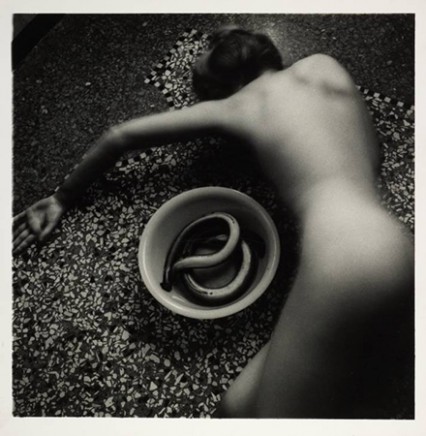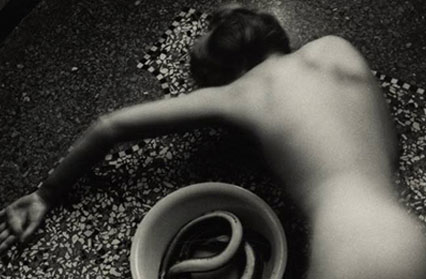Bodelwyddan Castle
Bodelwyddan Castle is an ancient site rebuilt, but retaining its castle form, between 1830 and 1833. From the elevation of its terrace, the view across the Vale of Clwyd is extensive. The expanse of Glan Clwyd hospital is in the foreground, the offshore Rhyl Flats wind-farm visible far-off in the haze of a May morning. Bodelwyddan shares a status with Beningbrough Hall in Yorkshire and Montacute in Somerset. In partnership with the National Portrait Gallery, it holds a display of that institution’s holding that reflects the period of the building. The many portraits of Victorian worthies are led by Queen Victoria, who hangs over a marble fireplace. A grand staircase, its brass rail lovingly polished, leads to an upper exhibition area. The setting and context make the small exhibition that is devoted to Francesca Woodman all the more startling and enthralling.

Two facts predominate about Francesca Woodman. She died in 1981 at the age of twenty-two and she left behind a body of work of ten thousand photographs. The tour that comes to Bodelwyddan, courtesy of the Art Fund and Arts Council of England, comprises eighteen that make for an absorbing exhibition of unique character.
The first surprise is the scale. Woodman’s theme is exposure and self-exposure. Her photographs are printed mainly in a five-inch square format occupying as little as a quarter of the total frame size. One image shrinks to a three-inch square. This size of presentation requires the visitor to draw close, and makes for a relationship of some intimacy between the viewer and the creator of the images. Many of the pictures, all in monochrome, are shot in haunting, abandoned rooms. The requirement for the proximity of the eye and the deep three-dimensionality make Woodman’s created world one that is distinctively her own.
A knowledge of art’s history, rather than a documentary approach, courses through her composition and lighting. Bodies are regularly half-seen or cut off at the torso akin to de Chirico or the surrealists. Two unidentified women in a photograph entitled ‘Untitled’ are cropped and off-centre. The large mirror in the scene has an importance that is equal to the human subjects. Woodman photographs herself, seated on a chair, naked and remote. The otherwise empty room has one window half-covered, another wholly boarded up. In apposition to the real human form, the floor has a disturbing figure of a human outlined in black. In another picture, the camera has been placed above the artist. She is kneeling forward on a large mirror, naked from the waist down. Her head is tilted sideways so as to gaze disturbingly upward towards the lens and the eye of the observer.
Darkness and half-light are frequent with the figures part-visible. Leipzig-born Max Klinger, who died in 1920, was one of her favourite artists. Enigmatically strange objects characteristically pervade his art, and Woodman regularly deploys unusual props. She arranges a collection of nine family photographs on a round table. She herself sits beside them, an unlit figure in the shadows apart from a penumbra of light around her hair. In a nearby image, another female subject is half-visible, waist and legs awkwardly posed. The image is centred on a chair in focus with a fur stole on it. Intimations of Sacher Masoch or the Velvet Underground hover.
Books, a line of clothes hung on pegs, a distressed piano all feature. In one, she has folded the human figure within a brick chimney or oven. The largest of the photographs depicts a body, hand to knee, on a patterned floor. The human form encircles a round bowl that contains in turn the circular form of a decapitated eel.
The darkness, the use of objects, the half-exposure all combine in a picture set in another near-empty room. Woodman has carefully balanced a door on the floor at an angle. She has then half-hidden her own self beneath it.
The eighteen works on display are taken from Artists Rooms, a collection of modern and contemporary art acquired by the Tate and the National Galleries of Scotland with help from Anthony d’Offay, the Art Fund and others. This is an enthralling exhibition.
Francesca Woodman continues at Bodelwyddan until 13 July.












